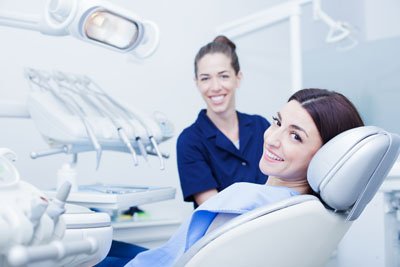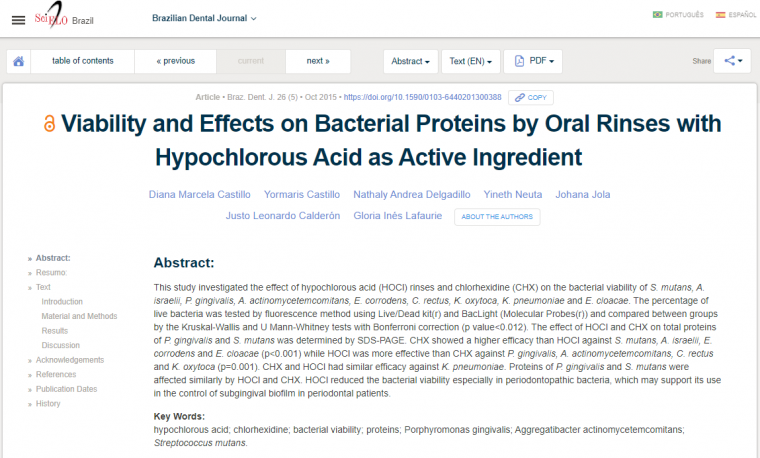- Your cart is empty
- Continue Shopping
Viability and Effects on Bacterial Proteins by Oral Rinses with Hypochlorous Acid as Active Ingredient
- Benefits, Dental, Medical Journal
- Posted on
-
by Admin-Art

Article • Braz. Dent. J. 26 (5) • Oct 2015 • https://doi.org/10.1590/0103-6440201300388

Reference source:
Abstract:
This study investigated the effect of hypochlorous acid (HOCl) rinses and chlorhexidine (CHX) on the bacterial viability of S. mutans, A. israelii, P. gingivalis, A. actinomycetemcomitans, E. corrodens, C. rectus, K. oxytoca, K. pneumoniae and E. cloacae. The percentage of live bacteria was tested by fluorescence method using Live/Dead kit(r) and BacLight (Molecular Probes(r)) and compared between groups by the Kruskal-Wallis and U Mann-Whitney tests with Bonferroni correction (p value<0.012). The effect of HOCl and CHX on total proteins of P. gingivalis and S. mutans was determined by SDS-PAGE. CHX showed a higher efficacy than HOCl against S. mutans, A. israelii, E. corrodens and E. cloacae (p<0.001) while HOCl was more effective than CHX against P. gingivalis, A. actinomycetemcomitans, C. rectus and K. oxytoca (p=0.001). CHX and HOCl had similar efficacy against K. pneumoniae. Proteins of P. gingivalis and S. mutans were affected similarly by HOCl and CHX. HOCl reduced the bacterial viability especially in periodontopathic bacteria, which may support its use in the control of subgingival biofilm in periodontal patients.
Discussion
There is an agreement on the effect of various antiplaque substances to reduce gingivitis in long term studies 4. However, the effective reduction of plaque and gingivitis in the short term is still under study. Chlorhexidine remains as the gold standard as antiplaque agent in short and long term effect 5. Despite their wide use, some adverse effects have discouraged its use, as tooth discoloration as it is easily mixed with the dietary chromogens, weak microbicidal activity at low concentrations and at high concentrations may produce dermatitis and desquamation of oral mucosa as well as delay in healing 14 15.
Hypochlorous acid rinses are proposed for plaque control and as a wound healing agent for its use in oral health, due to its low toxicity, high antimicrobial efficacy, anti-inflammatory effect, induction to cell proliferation and its background as a topical solution in the antisepsis of wounds in clinical medicine 16. HOCl has also the ability to oxidize the amino acid taurine and induce the formation of chlorine-taurine (TauCl) which has broad spectrum antimicrobial activity. The TauCl has a significant protective effect on tissues because it can inhibit the production of inflammatory mediators and thereby contribute to the processes of tissue protection 10.
In this study, HOCl showed a significant effect on Gram positive bacteria but did not exceed the effect of chlorhexidine. Chlorhexidine has shown better effect on Gram positive microorganisms but less on Gram negative microorganisms 17 18. The antimicrobial action of HOCl appears to be greater in Gram negative than in Gram positive possibly because Gram negative bacteria has sulfur and hem groups (rich in iron) in its membrane which causes an irreversible reaction HOCl/membrane proteins, producing structural damage, and altering cell permeability, affecting bacterial viability in Gram negative bacteria 19 20. The HOCl oxidizes and/or chlorinates endotoxins and exotoxins such as lipopolysaccharides and gingipains as Rgp and Kgp neutralizing their action. In Gram positive bacteria HOCl oxidizes glycine residues present in the peptidoglycan, on the other hand chlorination reactions in this group of microorganisms differs in the action on the target 21.
Different authors have controversial uses of microbiological culture methods to evaluate the efficacy of antimicrobials. The bacterial viability assessment with specific methods such as fluorochromes or epifluorescence has been proposed for evaluation of antimicrobials 22. In the present study a method of epifluorescence was used for the evaluation of the bacterial viability similar to the reported by other studies that have evaluated the substantivity of antiplaque substances 23 24.
Proteins of P. gingivalis and S. mutans were affected after 30 s of treatment with the test solutions. For P. gingivalis, after HOCl and CHX treatments it is observed a similar reduction of the protein concentrations in many bands when is compared with the untreated control. In S. mutans there is an elimination of almost all the proteins for the different treatments when compared with the untreated control. Cheung et al., in 2011 have shown changes in the proteic profile in Bacillus subtilis and E. coli after treatment with CHX, suggesting that the mechanism of action of CHX is related with an alteration of lipidic stability of the cell membrane 25. It is not clear which is the action of HOCl on bacteria, however oxidation and chlorination of amino groups in some functional and structural proteins in Gram positive and Gram negative bacteria is suggested 7. In further it is important to identify the proteins affected by HOCl action and thus explain how this antimicrobial molecule affects the bacterial viability and why in some Gram negative bacteria as E. cloacae does not have an important reduction in the viability.
The formulation of HOCl has been stabilized in Colombia and patented as an substance with antimicrobial effects for medical applications such as the treatment of chronic and non-healing wounds 11. Findings of this study could support future research of HOCl as antimicrobial and antiplaque agent in dentistry.
HOCl showed better effects on bacterial viability than CHX in Gram negative microorganism specially in P. gingivalis, A. actinomycetemcomitans and C. rectus. HOCl could have a significant effect on periodontophatic bacteria that could colonize and aggregates as dental biofilm.
Acknowledgements
The authors thanks to the Colombian Department for Science, Technology and Innovation (COLCIENCIAS) as the sponsor of this project through the Grant No 130850227678 To Dr. Marcela Buitrago for it assistance in the development of the SDS-Page.
References
- 1Palmer RJ. Oral bacterial biofilms – history in progress. Microbiology2009;155: 2113-2114.
- 2Teles RP, Teles FR. Antimicrobial agents used in the control of periodontal biofilms: effective adjuncts to mechanical plaque control? Braz Oral Res 2009;23Suppl1:39-48.
- 3Van Strydonck DA, Slot DE, Van der Velden U, Van der Weijden F. Effect of a chlorhexidine mouth rinse on plaque, gingival inflammation and staining in gingivitis patients: a systematic review. J. Clin. Periodontol 2012;39:1042-1055.
- 4Van Leeuwen MP, Slot DE, Van der Weijden GA. Essential oils compared to chlorhexidine with respect to plaque and parameters of gingival inflammation: a systematic review. J. Periodontol 2011;82:174-194.
- 5Neely AL. Essential oil mouth wash (EOMW) may be equivalent to chlorhexidine (CHX) for long-term control of gingival inflammation but CHX appears to perform better than EOMW in plaque control. J Evid Based Dent Pract 2012;12:69-72.
- 6Levine JM. Dakin’s solution: past, present, and future. Adv Skin Wound Care 2013;26:410-414.
- 7Green JN, Kettle AJ, Winterbourn CC. Protein chlorination in neutrophil phagosomes and correlation with bacterial killing. Free Radic Biol Med 2014;77:49-56.
- 8Wang L, Bassiri M, Najafi R, Najafi K, Yang J, Khosrovi B, et al.. Hypochlorous acid as a potential wound care agent: Part I. Stabilized hypochlorous acid: a component of the inorganic armamentarium of innate immunity. J Burns Wounds 2007;11;6:e5.
- 9Fu X, Kassim SY, Parks WC, Heinecke JW.Hypochlorous acid generated by myeloperoxidase modifies adjacent tryptophan and glycine residues in the catalytic domain of matrix metalloproteinase-7 (matrilysin): an oxidative mechanism for restraining proteolytic activity during inflammation. J Biol Chem 2003;278:28403-28409.
- 10Kim C, Cha YN. Taurine chloramine produced from taurine under inflammation provides anti-inflammatory and cytoprotective effects. Amino Acids 2014;46:89-100.
- 11Method of producing and applications of composition of hypochlorous acid. Available in: Available in: http://www.wipo.int/portal/en/ s.ds.d
» http://www.wipo.int/portal/en/ - 12Standard Guide for Assessment of Antimicrobial Activity Using a Time-Kill Procedure 1. International Standards Worldwide 2004;E:2315-03.
- 13Smith PK, Krohn RI, Hermanson G, Mallia A, Gartner FH, Provenzano M, et al.. Measurement of protein using bicinchoninic acid. Anal Biochem 1985;150:76-85.
- 14Jones CG. Chlorhexidine: is it still the gold standard? Periodontol2000 1997;15:55-62.
- 15Graziani F, Gabriele M, D’Aiuto F, Suvan J, Tonelli M, Cei S. Dental plaque, gingival inflammation and tooth -discolouration with different commercial formulations of 0.2% chlorhexidine rinse: a double-blind randomised controlled clinical trial. Oral Health Prev Dent 2015;13:101-111.
- 16Selkon J,B, Cherry GW, Wilson JM, Hughes M A. Evaluation of hypochlorous acid washes in the treatment of chronic venous leg ulcers. J Wound Care 2006;15:33-37.
- 17De Rossi A, Ferreira DC, da Silva RA, de Queiroz AM, da Silva LA, Nelson-Filho P. Antimicrobial activity of toothpastes containing natural extracts, chlorhexidine or triclosan. Braz Dent J 2014;25:186-190.
- 18Ferraz CC, Gomes BP, Zaia AA, Teixeira FB, Souza-Filho FJ. Comparative study of the antimicrobial efficacy of chlorhexidine gel, chlorhexidine solution and sodium hypochlorite as endodontic irrigants. Braz Dent J 2007;18:294-298.
- 19Rosen H, Klebanoff S. Oxidation of Escherichia coli iron centers by the myeloperoxidase-mediated microbicidal system. J Biol Chem 1982;257:13731-13735.
- 20Mckenna SM, Davies KJ. The inhibition of bacterial growth by hypochlorous acid. Possible role in the bactericidal activity of phagocytes. Biochem J 1988;254:685-692.
- 21Chong-Hou S, Hsein-Kun L. The role of hypochlorous acid as one of the reactive oxygen species in periodontal disease. J Dent Sci 2009;4:45-54.
- 22Berney M, Hammes F, Bosshard F, Weilenmann HU, Egli T. Assessment and interpretation of bacterial viability by using the LIVE ⁄DEAD Baclight Kit in combination with flow cytometry. Appl Environ Microbiol 2007;73:3283-3290.
- 23García-Caballero L, Carmona IT, González MC, Posse JL, Taboada JL, Dios PD. Evaluation of the substantivity in saliva of different forms of application of chlorhexidine. Quintessence Int 2009;40:141-144.
- 24Herrera D, Roldan S, Santacruz I, Santos S, Masdevall M, Sanz M: Differences in antimicrobial activity of four commercial 0.12% chlorhexidine mouth rinse formulations: an in vitro contact test and salivary bacterial counts study. J Clin Periodontol 2003;30:307-314.
- 25Cheung HY1, Wong MM, Cheung SH, Liang LY, Lam YW, Chiu SK. Differential actions of chlorhexidine on the cell wall of Bacillus subtilis and Escherichia coli PLoS One 2012;7:e36659.